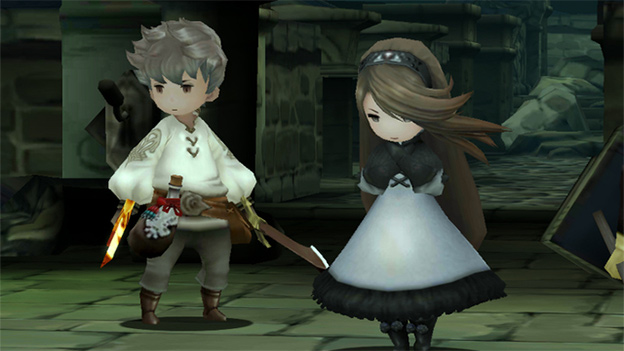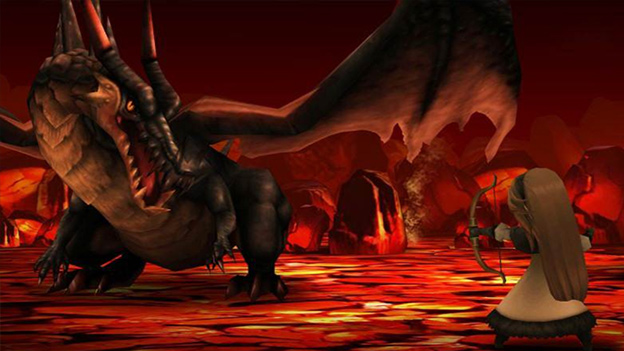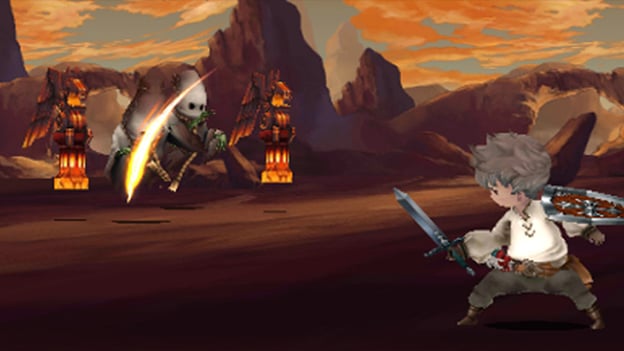Do Not Default on This Game
It’s been a cold, harsh winter, but Square Enix has prepared the perfect antidote for fans who remember the “Golden Age” of Japanese RPGs. Playing Bravely Default is like snuggling in front of the fire with a hot cocoa and a new book by a favorite author. It’s a warm, familiar feeling that nonetheless provides a few new twists to keep the experience fresh.
As is traditional, Bravely Default sets our hero on his journey with a hometown tragedy. Young shepherd Tiz sees his entire hometown and everyone he knows swallowed up by a giant chasm that opens in the earth. He soon joins forces with Agnés, a priestess on a journey to quell the natural disasters engulfing the earth by re-awakening four sacred crystals. The amnesiac rogue Ringabel (who wins my prize for having the best amnesiac RPG character name ever) and the fiery knight Edea round out the party. It’s a likeable cast that grows closer together during brief, poignant scenes and avoids pointless adolescent angst.
Along the way, our party traverses the wide world, encounters moments both lighthearted and tragic, and discovers the truth behind the crystal predicament. It’s not a groundbreaking story, but it doesn’t need to be. It’s a classic heroic journey with a few nice twists and turns along the way. The game plays with JRPG tropes (see: Ringabel) but doesn’t fall prey to many of them. There are no speeches about the power of friendship because the writers were confident in showing us the cast’s evolving relationships rather than shouting at us about them.
That’s not to say that the game entirely avoids narrative pitfalls. It spends quite a bit of time attempting to convince the player that its world shouldn’t be seen in terms of black and white, while simultaneously having the enemy faction perform some of the most heinously evil acts possible. There’s no moral gray area when it comes to genocide or abducting children and forcing them to act as mine canaries. The fact that the more upright enemy leaders chide the party for reviving the crystals while completely failing to explain why it’s a bad idea really starts to grate after the third or fourth time.

More damningly, the end of the game involves a lot of repeated boss fights. There’s a narrative reason for them, but all the same, they serve as a major roadblock to a story that had previously flowed quite nicely. The game’s overall quality and the fact that these fights serve up intriguing pieces of the story’s central mystery mitigates the annoyance, but still, this is one design flaw I hope not to see in future Bravely Default installments.
For many players the real star of Bravely Default is the combination of its class and battle systems. The game builds on classic turn-based combat with the Brave and Default system. Using Brave, a character can take up to four turns in a row, but forfeits the ability to act until the turn deficit is made up. Default allows the character to skip a turn while in a defensive stance, saving up extra turns for the future.

It may seem like a simple change, but the ability to manipulate turns in this way opens up a host of strategic possibilities for the player, along with providing interesting combat challenges when foes use the system. It meshes perfectly with the game’s job system, in which the player can collect over twenty possible character classes by defeating enemy commanders over the course of the game. These jobs can be swapped freely outside of battle, and as each character levels up various jobs, they’re given the ability to mix and match the skill sets and abilities that they’ve learned.
By mid-game, the synergy between Bravely Defaulting and the job system becomes clear. A ninja with spell fencer skills can use Brave to enchant her swords with fire, attack the enemy twice, then use a ninja evasion skill, all in a single turn. She won’t be able to act for three turns afterward, but since each character Braves or Defaults separately, the party’s healer can look after her while she’s recovering. These kinds of assaults become important as enemies also tend to Brave or Default, requiring the player to learn their attack patterns and attack during moments of vulnerability. It’s a great deal of fun to build strategies using these systems, the kind of fun that will keep hardcore RPG fans entertained for hours on end.
With so many jobs, it’s natural that certain professions are more useful than others. The Salve Maker profession is absolutely vital in the mid-game, where several boss fights require the item-based attack and healing skills that the profession provides. The ninja profession is also almost mandatory for one important series of side quest boss fights late in the game. Still, there’s a lot of room for players to pick class combinations that work well for them, and the game’s challenges also push the player to change things up and use new cross-class strategies for different situations.
This wouldn’t be a modern JRPG without various side activities and sub-systems to dabble with. Fortunately, they’re streamlined well and worked logically into the gameplay. There are no MMORPG-style fetch quests like the ones seen in the game’s demo, just the main quest and the “optional” adventures which result in gaining new jobs for the party. The only major side activity is rebuilding Tiz’ hometown of Norende, which involves collecting villagers via StreetPasses or by connecting to the Internet once per day for three free villagers. Norende gives players a nice selection of items to purchase, as well as providing special attacks that can be customized and sent out over the Internet.

Collected StreetPasses, SpotPasses, and online friends who play the game can be summoned into battle and can also be linked to characters, giving a player access to abilities they haven’t yet earned. None of this is necessary to beat the game, however. Job choice and strategy is usually more important than sheer power in battle, so smart players won’t need or want to rely on summoning powerful allies from parts of the world that received the game several months ago.
Bravely Default’s story and combat take place against a richly illustrated world with a hand-drawn look. The character and monster models look fantastic on the 3DS, and part of the joy of getting a new job is checking out how its outfit looks on each of the four characters. The world itself boasts gorgeous, highly imaginative cities, although the best of them are seen early in the game. Sadly, the dungeon environments aren’t nearly as interesting or imaginative as the world above, but they at least boast the occasional puzzle and are easy to navigate with the maps on the bottom screen.
The music and sound design are also nice, with appropriately evocative musical tracks and battle sound effects that give attacks extra impact. The English voice acting sounds better in the context of the full game than it did in the demo and previews, though some performances are notably better than others. Players can switch to the original Japanese voice track if they find the English to be grating.
All of the game’s elements come together in an impressive whole that lasts for a good, long while. It’s a meaty experience set in a lovely world with an entertaining battle system and an endearing cast of characters. It’s been some time since we saw a worthy successor to the turn-based fantasy JRPG tradition, but we have one here.
In short, Bravely Default is the Japanese RPG that we’ve been waiting for. As many JRPG companies cram increasingly bizarre gimmicks, half naked underage-looking girls, or overly convoluted plots into their games, Bravely Default reminds us that it’s possible to go back to basics without feeling stale. This classic Final Fantasy-style game is beautifully executed, fun to play, and not to be missed by anybody who has ever loved the JRPG genre.
RATING OUT OF 5 RATING DESCRIPTION 4.0 Graphics
A lovely hand-drawn style graces the game, looking fantastic everywhere except the dungeons. 5.0 Control
The Bravely Default combat and job system are the best that turn-based JRPGs have seen in years. 3.9 Music / Sound FX / Voice Acting
Strong music and sound, decent but not spectacular voice acting. 4.4 Play Value
A terribly entertaining, meaty adventure that stumbles slightly with too much boss fight repetition near the end. 4.5 Overall Rating – Must Buy
Not an average. See Rating legend below for a final score breakdown.
| Review Rating Legend | |||
|---|---|---|---|
| 0.1 – 1.9 = Avoid | 2.5 – 2.9 = Average | 3.5 – 3.9 = Good | 4.5 – 4.9 = Must Buy |
| 2.0 – 2.4 = Poor | 3.0 – 3.4 = Fair | 4.0 – 4.4 = Great | 5.0 = The Best |
Game Features:
